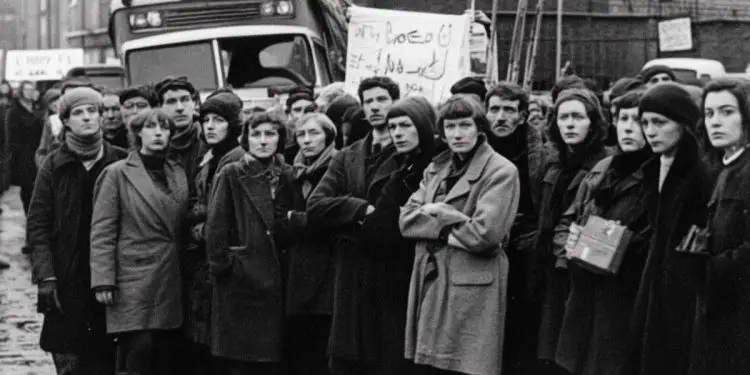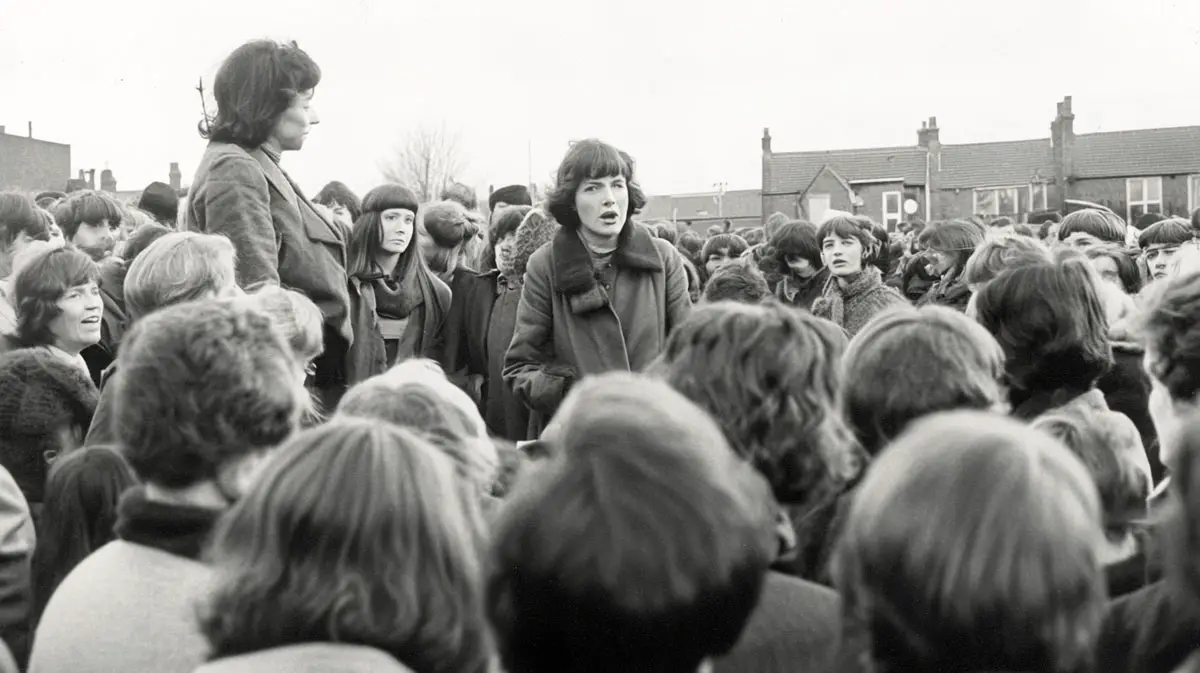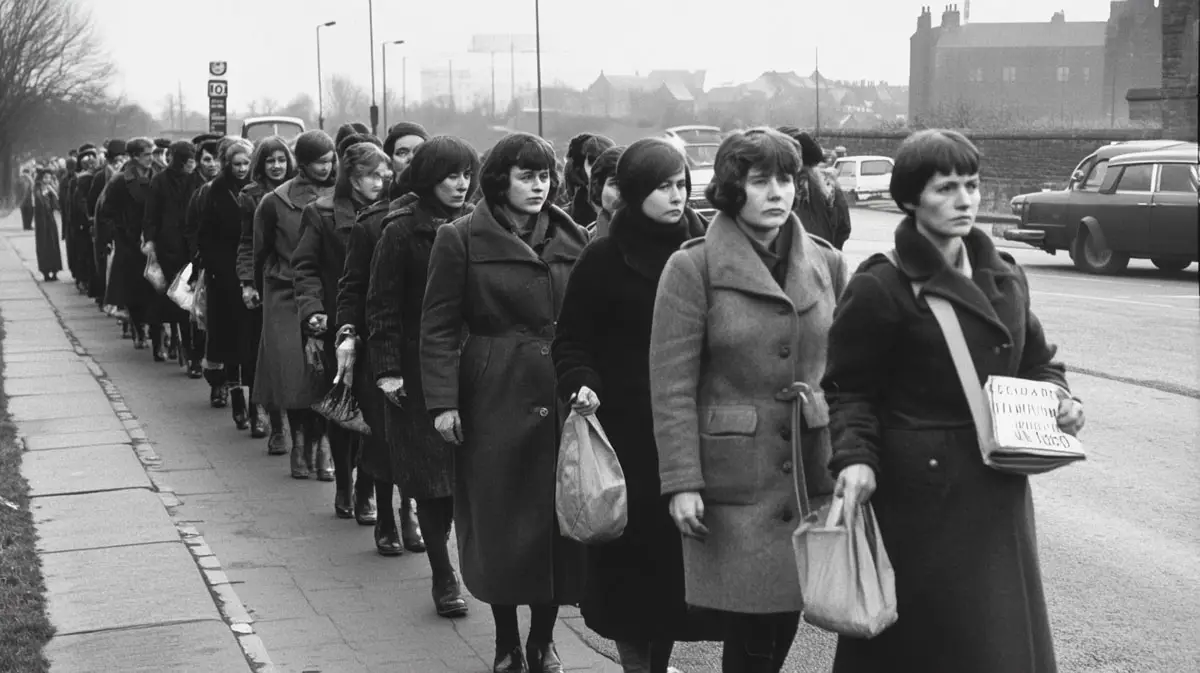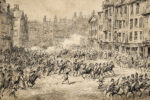The 1970 Clothing Strike of Leeds

By Harry Bratley
Up to the mid-twentieth century, Leeds was the centre of the British textile industry, supplying clothing throughout the country and beyond, with over 60 per cent of suits sold in the UK made in Leeds. The Montague Burton clothing factory in Harehills was, at one time, the largest anywhere in the world and the first to sell ready-to-wear suits. The clothing you could buy from one of their shops was the full package – suit, waistcoat, shirt, socks, and underwear – literally the ‘Full Monty’ – the full Montague Burton. His factory churned out over 30,000 suits a week and dressed the nation.
Although textiles were a thriving industry in the city, wages were low, and for women, who made up two-thirds of the workforce, they were the lowest paid of all. In February 1970, clothing workers, most of them women, began an unofficial strike in support of their demand for a one shilling per hour increase. The strike was an angry reaction to a settlement between the National Union of Tailors and Garment Workers (NUTGW) and the Clothing Manufacturers’ Federation agreeing new pay scales of 6 shillings and 7 pence per hour for skilled men, but only 4 shillings and 9 pence for skilled women. Low wages, pay disparities between men and women, and a new, unacceptable productivity agreement were all issues behind the strike.
The strike started on 12 February 1970 at the John Collier factory in Kirkstall, gathering momentum as strikers marched from clothing factory to clothing factory until almost 30,000 people were involved, the majority of them women. This new tactic by these somewhat inexperienced strikers was a new method of seeking support for the strike from workers in other factories, which later became known as ‘Flying Pickets’ – a system of organising which became a significant aspect of later coal miners’ struggles.
As a reaction to the walkouts, the NUTGW asserted that the strike was unofficial and was against their advice, and that the pay agreement should be honoured and not broken, as it was beneficial to the vast majority of the union’s membership. The male-led union was not motivated to ensure that the objectives of its largely female members were represented. This attitude isolated the women strikers from their own union and, in response, they challenged officials by forming their own grassroots workers’ committee.
“Lay off thousands of workers”
Reporting on the dispute, The Times suggested that the strike was the work of left-wing activists, and not a collective flood of anger and frustration by thousands. Two of the strike shop stewards, Gertie and Jim Roche, were socialists, but the strikes did not start in the factories where they worked. In a letter to the Yorkshire Evening Post, Gertie Roche stated that at every one of their meetings, the women were intensely involved, unleashing years of resentment. She pointed out that in the twentieth century, almost every day references are made about equal rights for women, and the revolt is not due to a handful of left-wingers, but to something far deeper – twenty years of neglect by employers.
George Little, Chairman of the Leeds and Northern Clothing Manufacturers’ Association, admitted that the Leeds employers did not quite know what had hit them. They never believed that a calamity of this size could ever befall an industry where workers, primarily women, have so often been content to accept low wages. Women strikers marching through the streets of the city and female pickets calling on individual factories to bring out their workers in support of the strike was almost unique in British industrial disputes.
The strike soon began to cause severe problems for clothing production in the city as other workers started to support the strike. The Montague Burton management decided to close their entire factory after all their despatch men joined the women strikers. The walkouts also started to affect the textile businesses in other parts of the country. It was reported that clothing factories throughout the north may have to lay off thousands of workers because of the unofficial strike in Yorkshire. The North-East factory of John Collier in South Shields was closed, and 700 women were told to go home indefinitely. The management were forced to close down because they were unable to get materials from Leeds. The company also had to shut down in Middlesbrough until further notice. In less than two weeks of action, the female strikers were already causing major problems for the employers, with a spokesman from the NUTGW warning that other factories throughout the North may have to close.
Emotions in the dispute were running high, and the police had to be called to David Little’s clothing factory in Park Place when pickets threatened to drag non-striking workers from the building. By the fourth week of the strike, the clothing industry in Leeds had come to a complete standstill. With the dispute widening to businesses in other parts of the country, the NUTGW realised that the union had lost control of the situation and, although this was an unofficial strike, they now had to get involved. Union officials met with shop stewards, putting forward a proposal to end the strike, recommending a return to work so that the union could negotiate with the employers. Although not ideal, the shop stewards narrowly voted to accept the offer and return to work by a small margin of 83 to 76. However, at a mass meeting of over 4,000 strikers the next day, there was a unanimous vote to stay out. On hearing this, the union continued to forcefully pressure the shop stewards to again recommend a return to work, as neither the union nor the employers would negotiate if the strike continued. Realising that they had been outmanoeuvred by both their own union and the employers, this time the strikers went back. Eventually, a new agreement was negotiated by the union for an increase of 10 pence per hour for women and 8 pence per hour for men, on top of the previous agreement. Although this was extra money all round, it hardly addressed the pay discrepancies between men and women in the industry.
“Undermine wages”
As for newspaper coverage, The Workers’ Press, a Trotskyist left-wing newspaper, maintained that the strikers were betrayed by the NUTGW, who should have backed the strike and pressed harder on behalf of their lowest-paid members. The Morning Star, a Communist daily newspaper, applauded the gains made by the strikers, and The Times suggested that the strike committee’s decision to return to work had been taken to avoid damaging the industry. However, the NUTGW official publication, the Garment Worker, did not want to publicise an unofficial strike in which many of its members saw the leadership as – described by one shop steward – ‘incompetent, inept, and at times, downright cowardly’. The journal’s only reference to the strike itself was a statement by the union executive acknowledging the ‘widespread and justifiable feelings of resentment at the industry’s low wage structure.’ In the next edition, it reported that a special conference had given massive support to the union’s executive, claiming that the dispute nudged them into renewed action, highly praising the fact that the union had won the finest advance ever for clothing workers. No articles or photographs appeared in either edition to illustrate and describe the strike, or its impact on workers’ lives.
Very quickly, inflation rapidly weakened the value of this wage agreement, and employers further sought to undermine wages through the extended function of productivity agreements (agreed with the union), and payment by results. In the aftermath of the strike, employers contrived to subvert the collective strength of the rank and file by moving production from ‘strike-prone’ Leeds to Middlesbrough and permanently reclassifying women’s work as unskilled to circumvent the recently introduced Equal Pay Act 1970.
The Leeds Clothing Strike was portrayed in a BBC Play for Today – Leeds United! – in 1974. The play was written by Colin Welland, whose mother-in-law was involved in the strike, and he interviewed many of those involved while preparing his script. The programme provoked controversy at the time, with angry responses not only from the employers but also the bureaucracy of the union and the Communist Party. The latter two clearly played a despicable role in the dispute, and the play exposes the bureaucratic manoeuvres of the union officials with the bosses.
The outcome of the strike was not the expected success. Despite the strength and committed determination of the workforce, the unofficial strike was undermined by their own union getting too close to the employers and leaving their members out in the cold and struggling on the breadline.
images are representational












